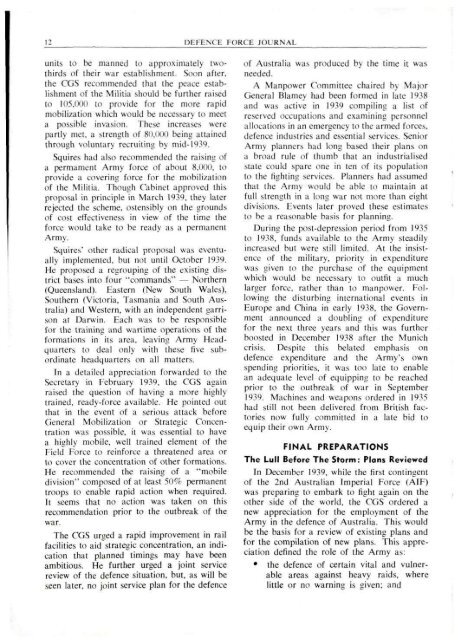ISSUE 1 : Nov/Dec - 1976 - Australian Defence Force Journal
ISSUE 1 : Nov/Dec - 1976 - Australian Defence Force Journal
ISSUE 1 : Nov/Dec - 1976 - Australian Defence Force Journal
Create successful ePaper yourself
Turn your PDF publications into a flip-book with our unique Google optimized e-Paper software.
DEFENCE FORCE JOURNALunits to be manned to approximately twothirdsof their war establishment. Soon after.the CGS recommended that the peace establishmentof the Militia should be further raisedto 105,000 to provide for the more rapidmobilization which would be necessary to meeta possible invasion. These increases werepartly met, a strength of 80,000 being attainedthrough voluntary recruiting by mid-1939.Squires had also recommended the raising ofa permament Army force of about 8,000, toprovide a covering force for the mobilizationof the Militia. Though Cabinet approved thisproposal in principle in March 1939, they laterrejected the scheme, ostensibly on the groundsof cost effectiveness in view of the time theforce would take to be ready as a permanentArmy.Squires' other radical proposal was eventuallyimplemented, but not until October 1939.He proposed a regrouping of the existing districtbases into four "commands" — Northern(Queensland). Eastern (New South Wales),Southern (Victoria, Tasmania and South Australia)and Western, with an independent garrisonat Darwin. Each was to be responsiblefor the training and wartime operations of theformations in its area, leaving Army Headquartersto deal only with these five subordinateheadquarters on all matters.In a detailed appreciation forwarded to theSecretary in February 1939, the CGS againraised the question of having a more highlytrained, ready-force available. He pointed outthat in the event of a serious attack beforeGeneral Mobilization or Strategic Concentrationwas possible, it was essential to havea highly mobile, well trained element of theField <strong>Force</strong> to reinforce a threatened area orto cover the concentration of other formations.He recommended the raising of a "mobiledivision" composed of at least 50% permanenttroops to enable rapid action when required.It seems that no action was taken on thisrecommendation prior to the outbreak of thewar.The CGS urged a rapid improvement in railfacilities to aid strategic concentration, an indicationthat planned timings may have beenambitious. He further urged a joint servicereview of the defence situation, but, as will beseen later, no joint service plan for the defenceof Australia was produced by the time it wasneeded.A Manpower Committee chaired by MajorGeneral Blarney had been formed in late 1938and was active in 1939 compiling a list ofreserved occupations and examining personnelallocations in an emergency to the armed forces,defence industries and essential services. SeniorArmy planners had long based their plans ona broad rule of thumb that an industrialisedstate could spare one in ten of its populationto the fighting services. Planners had assumedthat the Army would be able to maintain atfull strength in a long war not more than eightdivisions. Events later proved these estimatesto be a reasonable basis for planning.During the post-depression period from 1935to 1938, funds available to the Army steadilyincreased but were still limited. At the insistenceof the military, priority in expenditurewas given to the purchase of the equipmentwhich would be necessary to outfit a muchlarger force, rather than to manpower. Followingthe disturbing international events inEurope and China in early 1938, the Governmentannounced a doubling of expenditurefor the next three years and this was furtherboosted in <strong>Dec</strong>ember 1938 after the Munichcrisis. Despite this belated emphasis ondefence expenditure and the Army's ownspending priorities, it was too late to enablean adequate level of equipping to be reachedprior to the outbreak of war in September1939. Machines and weapons ordered in 1935had still not been delivered from British factoriesnow fully committed in a late bid toequip their own Army.FINALPREPARATIONSThe Lull Before The Storm: Plans ReviewedIn <strong>Dec</strong>ember 1939, while the first contingentof the 2nd <strong>Australian</strong> Imperial <strong>Force</strong> (AIF)was preparing to embark to fight again on theother side of the world, the CGS ordered anew appreciation for the employment of theArmy in the defence of Australia. This wouldbe the basis for a review of existing plans andfor the compilation of new plans. This appreciationdefined the role of the Army as:• the defence of certain vital and vulnerableareas against heavy raids, wherelittle or no warning is given; and
















